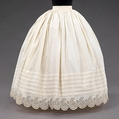Petticoat
Not on view
During the nineteenth century, women had an extensive array of underpinnings, which could include a chemise, drawers, corset, corset cover, camisole, skirt supports and petticoats. Although to the modest nineteenth-century woman, it would be scandalous for any of these items to be seen, some underclothes were made of sumptuous silks and beautifully decorated with embroidery, ribbons and lace. This particular example incorporates refined cartridge pleating at the waist, which reined in the voluminous amount of fabric needed to accommodate the full-skirted silhouette of the period. The motif of the eyelet embroidery illustrates the enduring fascination with the paisley motif. The boteh, or paisley, originated in Persia and was disseminated to the Western world through Indian shawls which were at the height of popularity at this time. As was customary, the name of the owner was handwritten in ink for purposes of indentifying ownership for laundering.
Due to rights restrictions, this image cannot be enlarged, viewed at full screen, or downloaded.
This artwork is meant to be viewed from right to left. Scroll left to view more.



